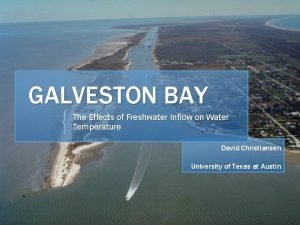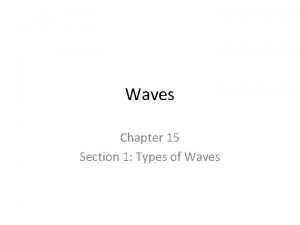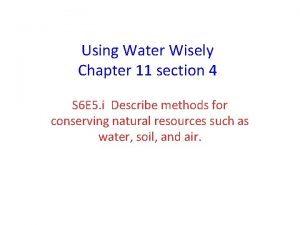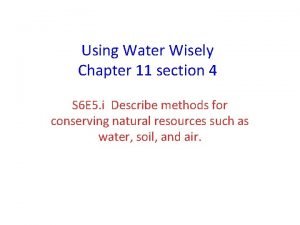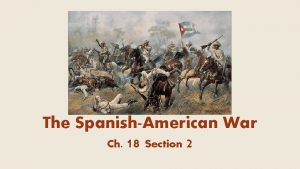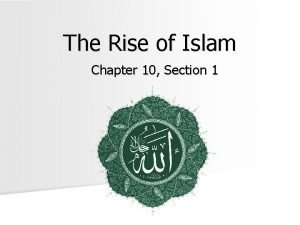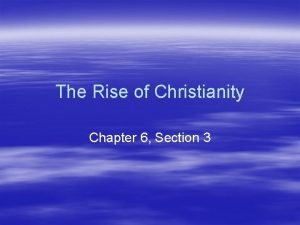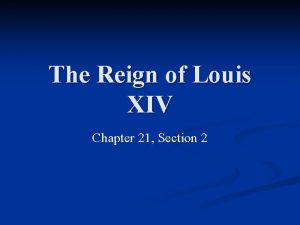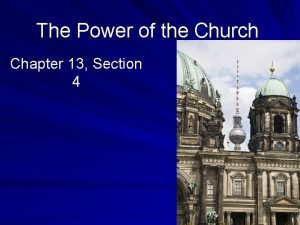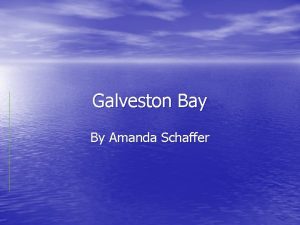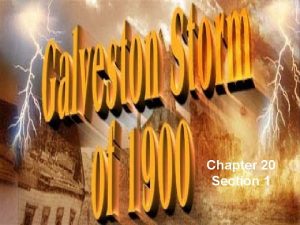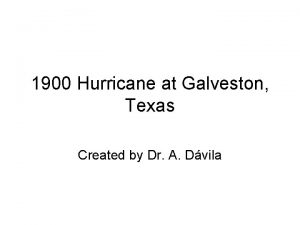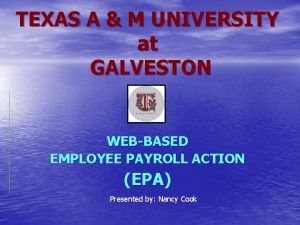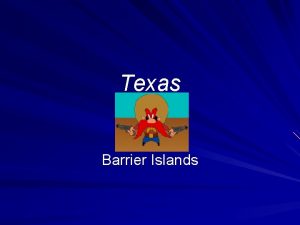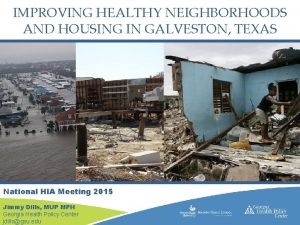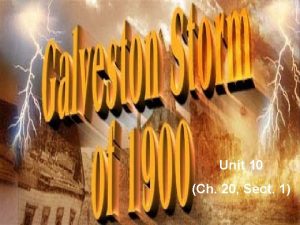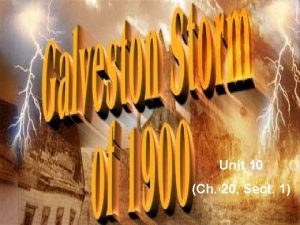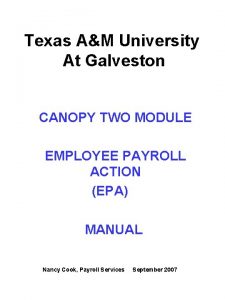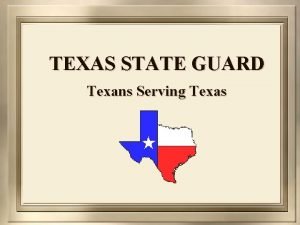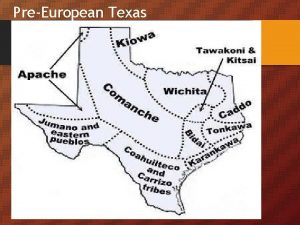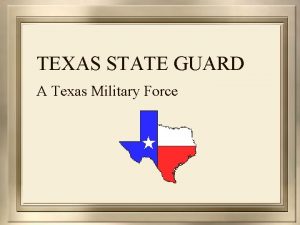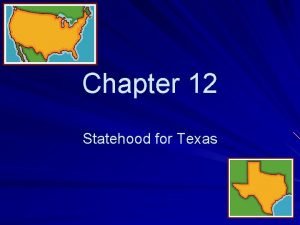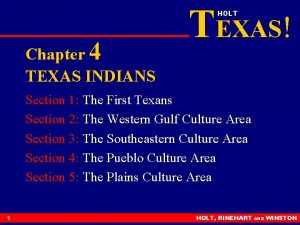Chapter 20 Section 1 Galveston Texas Galveston is







































- Slides: 39

Chapter 20 Section 1

Galveston, Texas • Galveston is located on Galveston Island, 50 SE of Houston • Galveston has been the home to – Native Americans- Karankawas – Pirates- Lafitte – Revolutionary Governments • Began in April of 1838



Galveston, Texas • Mexico used Galveston as a port due to its naturally deep harbor. • In 1800 s Galveston was a center for Cotton shipping for Texas and the U S. • Largest city in Texas from 1870 -80 – 22, 248 people

Loading Cotton in Galveston

“Wall Street of the Southwest” • During the late 1800 s Galveston was Texas’ most refined city. – Beautiful architecture • Galveston enjoyed its role as the financial center of Texas, a true White. Collar City. • First Texas city to have – electric lights – telephone – baseball team

Ashton Villa

The Bishops Palace

The Grand 1894 Opera House

September 1900 • By early September 1900, citizens of Galveston hear about a storm in the Gulf of Mexico • Did not know how powerful it was • Most citizens disregarded the warnings given by Isaac Cline

Dr. Isaac Cline The city’s representative of the U. S. Weather Bureau

September 7, 1900 • Dr. Cline notices unusual swells in the gulf as he makes his rounds, but nothing signaling what’s to come. • Dr. Cline received messages from the Weather bureau as Galveston had been put under a storm warning as early as Sept 4. • Galveston’s 38, 000 residents go to sleep that night unaware of the fate that awaits them

1900 Storm Path

Hurricane Ike Path

September 8, 1900 • Early in the day, water begins to flood homes blocks from the beach • Galveston’s highest point above sea level was only 8. 7 feet and people begin to move to higher ground and into tall buildings • As flood waters rise the bridge to mainland is destroyed by a boat that escapes its moorings

September 8, 1900 • By the early evening, the winds began to blow the deadly storm surge onto the island • A storm surge of 15. 7 feet swept over the island completely submerged it. • People fled to the second and third stories of high buildings • Winds estimated at near 130 mph gusts

September 8, 1900 • As people fled the storm, many were killed by flying debris from houses that had been destroyed by wind and water • People clung to anything to keep afloat. • By night time the city was in utter darkness as the gasworks for city lighting was destroyed.

September 8, 1900 • By 11: 00 pm, the winds turned from the south and the storm began to weaken • By the next morning the storm was gone and devastation was left in its wake: 1. 6, 000 -8, 000 people dead on the island 2. 3, 600 building destroyed 3. $20 million in damage done to the island = to $700 million today





Causeway before the storm Causeway after the storm




Aftermath • Galveston had to recover • Bodies were collected to be identified and then a plan was made to dispose of them • Bodies were staked on barges and weighted down to be sunk in the gulf. • A few days later the bodies washed back onto the island.

Aftermath • The city officials decided to burn all the bodies. • Many African-American citizens were put in charge of burning the bodies. • Galveston asked for assistance from the governor to prevent riots in the city • 125 people were shot for looting from houses and from the dead bodies.


Changes After the Storm • Galveston changed its City Government to a commission system to speed up the process of recovering • A seawall was proposed to block the island from deadly storm surges • The city planned to raise it’s elevation by bringing in sand from the gulf


The Seawall • Galveston built a 17 foot sea wall that extends for over three miles of the islands coastline. • They increased the elevation of the town by 16 feet • These projects were completed by 1904, causing Galveston to miss out on the oil boom.



Galveston Today • Galveston resumed its role as a port of entry for Texas immigrants after the Hurricane • However, Houston overtook Galveston as the most important port city in Texas when the Houston Ship Channel was built.

The Strand Historical District

Galveston Today • Galveston’s economy today is based largely on tourism. • It is also the home of the two Universities: – Texas A&M University @ Galveston – University of Texas Medical Branch

VIEW OF GALVESTON TEXAS LOOKING TOWARDS THE GULF
 Modifiye parkland formülü
Modifiye parkland formülü Galveston isd human resources
Galveston isd human resources Galveston bay water temp
Galveston bay water temp Chapter 10 section 1 meiosis worksheet answer key
Chapter 10 section 1 meiosis worksheet answer key Dimensioning section views
Dimensioning section views A revolved section is drawn for
A revolved section is drawn for Half section view drawing
Half section view drawing Section 2 describing energy worksheet answers
Section 2 describing energy worksheet answers Chapter 17 section 3 luther leads the reformation
Chapter 17 section 3 luther leads the reformation Chapter 30 section 2 world history
Chapter 30 section 2 world history What was the counter-reformation?
What was the counter-reformation? Chapter 10 section 2 central america and the caribbean
Chapter 10 section 2 central america and the caribbean Unit 14 lesson 1 drivers ed
Unit 14 lesson 1 drivers ed Wilson fights for peace
Wilson fights for peace The wave chapter 15
The wave chapter 15 Chapter 24 section 2 watergate answers
Chapter 24 section 2 watergate answers Chapter 11 section 4 using water wisely answer key
Chapter 11 section 4 using water wisely answer key We think we are using water wisely because
We think we are using water wisely because Chapter 6 section 1 combining supply and demand answers
Chapter 6 section 1 combining supply and demand answers Chapter 5 section 4
Chapter 5 section 4 Turmoil and change in mexico
Turmoil and change in mexico Chapter 14 section 2 totalitarianism
Chapter 14 section 2 totalitarianism Chapter 22 section 5 the end of the war and its legacy
Chapter 22 section 5 the end of the war and its legacy Chapter 19 section 1 the unalienable rights
Chapter 19 section 1 the unalienable rights Chapter 5 section 2 the supply curve shifts
Chapter 5 section 2 the supply curve shifts Chapter 18 section 4 the special courts worksheet answers
Chapter 18 section 4 the special courts worksheet answers Valeriano butcher weyler
Valeriano butcher weyler The scramble for africa chapter 11 section 1
The scramble for africa chapter 11 section 1 The scramble for africa chapter 27 section 1 answers
The scramble for africa chapter 27 section 1 answers Chapter 6 section 1 the scientific revolution
Chapter 6 section 1 the scientific revolution Qiyamm
Qiyamm Chapter 10 section 1 guided reading the rise of islam
Chapter 10 section 1 guided reading the rise of islam Chapter 6 section 3 the rise of christianity answer key
Chapter 6 section 3 the rise of christianity answer key Chapter 21 section 2 the reign of louis xiv
Chapter 21 section 2 the reign of louis xiv The reformation continues chapter 17 section 4
The reformation continues chapter 17 section 4 Chapter 13 section 4 the power of the church
Chapter 13 section 4 the power of the church Chapter 12 section 1 the politics of reconstruction
Chapter 12 section 1 the politics of reconstruction The northern renaissance chapter 17 section 2
The northern renaissance chapter 17 section 2 Chapter 11 section 2 the north transformed
Chapter 11 section 2 the north transformed Chapter 24 section 1: the nixon administration answers
Chapter 24 section 1: the nixon administration answers


